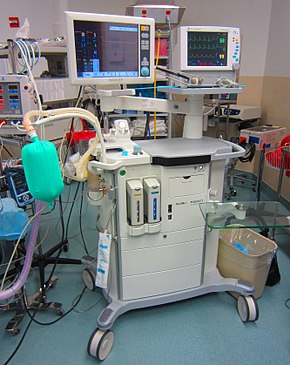
Back علامات حيوية Arabic Signes vitals Catalan ᏄᏛᎾᏕᎬ ᎠᏰᎸ ᎧᏃᎮᏍᎩ CHR Vitalparametre Danish Vitalparameter German Parametroj de vivanto Esperanto Signos vitales Spanish علائم حیاتی Persian Elonmerkki Finnish Signes vitaux French
| Vital signs | |
|---|---|
 An anesthetic machine with integrated systems for monitoring of several vital parameters, including blood pressure and heart rate | |
| Purpose | assess the general physical health of a person |
Vital signs (also known as vitals) are a group of the four to six most crucial medical signs that indicate the status of the body's vital (life-sustaining) functions. These measurements are taken to help assess the general physical health of a person, give clues to possible diseases, and show progress toward recovery.[1][2] The normal ranges for a person's vital signs vary with age, weight, sex, and overall health.[3]
There are four primary vital signs: body temperature, blood pressure, pulse (heart rate), and breathing rate (respiratory rate), often notated as BT, BP, HR, and RR. However, depending on the clinical setting, the vital signs may include other measurements called the "fifth vital sign" or "sixth vital sign."
Early warning scores have been proposed that combine the individual values of vital signs into a single score. This was done in recognition that deteriorating vital signs often precede cardiac arrest and/or admission to the intensive care unit. Used appropriately, a rapid response team can assess and treat a deteriorating patient and prevent adverse outcomes.[4][5][6]
- ^ "Vital Signs".
- ^ "Emergency Physicians Home". www.emergencyphysicians.org.
- ^ "Vital Signs Table - ProHealthSys". 3 July 2013.
- ^ National Early Warning Score Development and Implementation Group (NEWSDIG) (2012). National Early Warning Score (NEWS): standardising the assessment of acute-illness severity in the NHS. London: Royal College of Physicians. ISBN 978-1-86016-471-2.
- ^ National Institute for Health and Clinical Excellence. Clinical guideline 50: Acutely ill patients in hospital. London, 2007.
- ^ "Acute care toolkit 6: the medical patient at risk: recognition and care of the seriously ill or deteriorating medical patient" (PDF). Royal College of Physicians of London. May 2013.